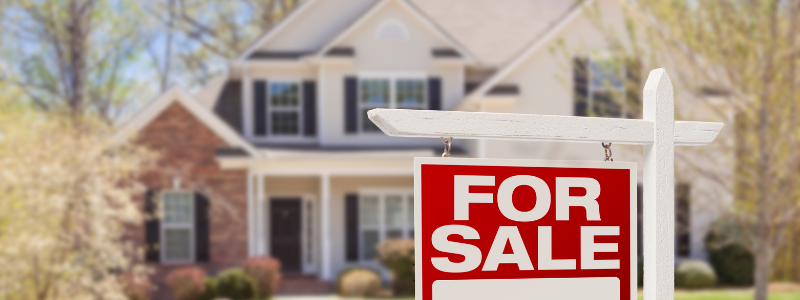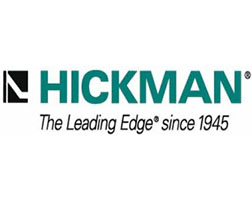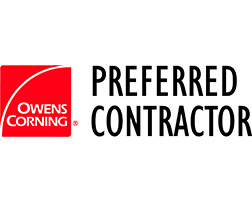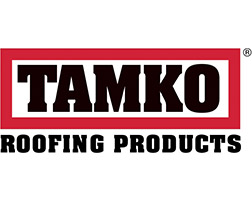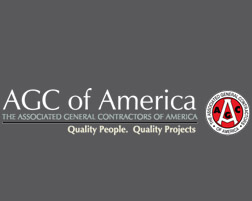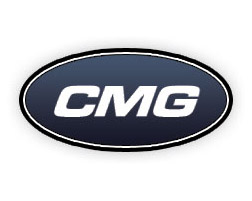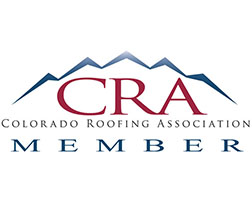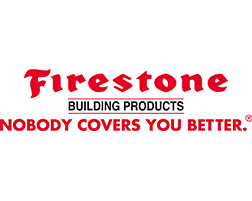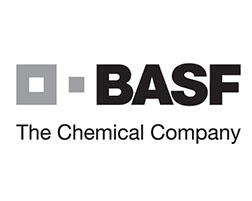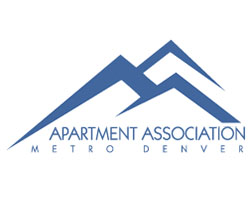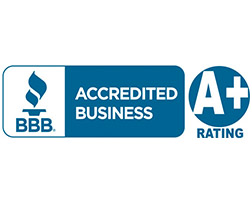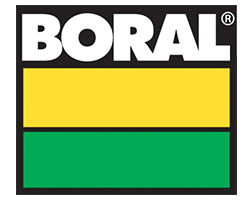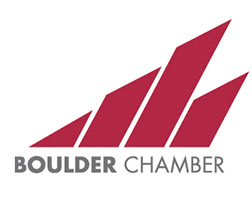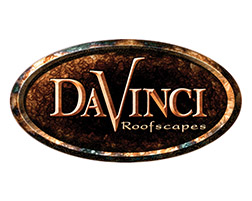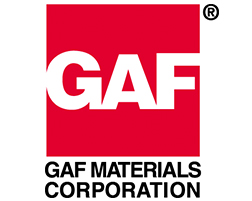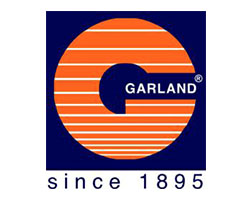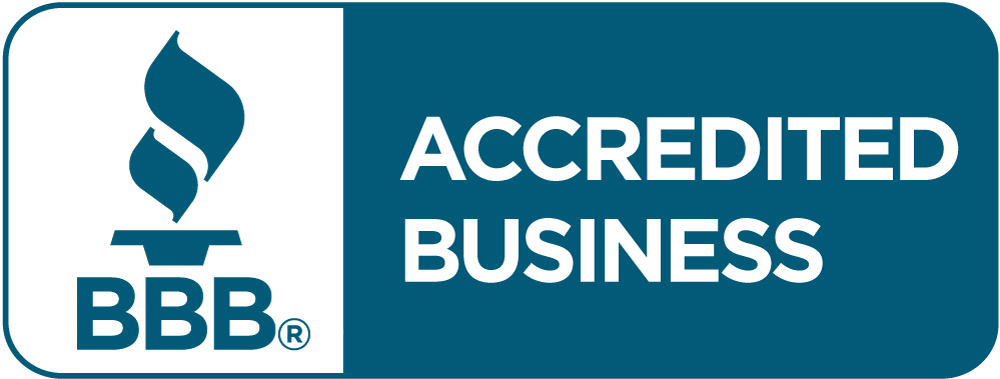Buying A House With A 20-Year-Old Roof
A roof is a home’s most important facet. Without a roof – or, without a good roof – everything in that home is susceptible to rain, snow, intense wind, strong heat, UV rays, and so much more. But, with a roof – a good, new one, in particular – your home is completely protected, ensuring that you and your loved ones are safe and that everything you own is completely protected.
Because of this, when searching for a new home, it is so important that you pay close attention to the age and wear of the roof of each house that you look at.
Buying a house with a 20-year-old roof means that, in the near future, you may be facing roof repairs or a roof replacement.
Inspect The Roof Before Purchasing The House
Just about every house that you find for sale will have some wear and tear. But, there are some houses that have older roofs – twenty years old, for instance – and these roofs have seen a lot more wear and tear than the roofs on other houses. Making sure that the roof of your new home is in decent shape, while also determining whether repairs are necessary for the near future, is extremely important. To accomplish both tasks in as little time as possible, having the roof inspected before you purchase the house is the best choice.
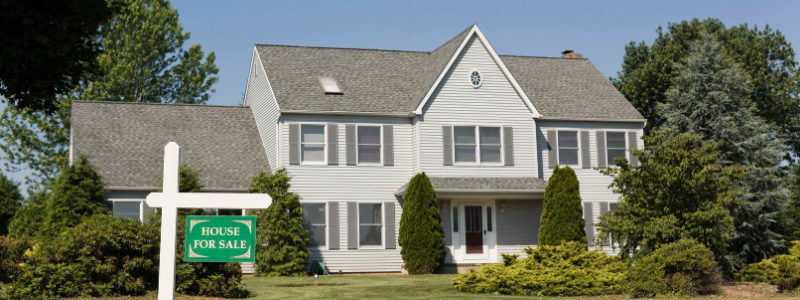
Your Budget Should Account for Roof Repairs
Even if you feel confident in the house that you’ve chosen to buy, if the roof is very old, then an inspection is a necessity. By purchasing the house, without having the roof inspected, it’s likely that a series of unforeseen issues may arise, most of which will be due to the roof’s age. But, if you have the roof inspected before you purchase the house, you can determine the condition of that roof, whether repairs are necessary and, if so, what those repairs are and when they should take place.
By doing an inspection before purchase, you can add into account the cost of roof repairs when you make an offer on the house.
A professional roof inspection consists of inspecting the roof’s exterior and, then, the roof’s interior. The roof exterior inspection consists of going onto the roof and examining the condition of the roof shingles, flashing, and chimney. The roof interior inspection consists of going into the attic and checking the insulation and ventilation, while also checking for leaks and mold. Right after the inspection is complete, you will learn the condition of the roof, any issues that are present, and what needs to be done to fix those particular issues.
What Should You Look For In An Old Roof And When Should You Walk Away?
As you look for your new home, there are a few attributes of each house’s roof that you must look for and take note of. Each one of these attributes will greatly affect the quality and condition of the roof, and those will, in turn, affect your experience living in your new home. By paying attention to these attributes, you will be able to know when to purchase a house and when you should walk away.
Every roof will be a little different. But, regardless of those general differences, there are a few attributes to look for in every roof that you check. These attributes will affect the quality and condition of the roof, as well as your experience in that house, tremendously.
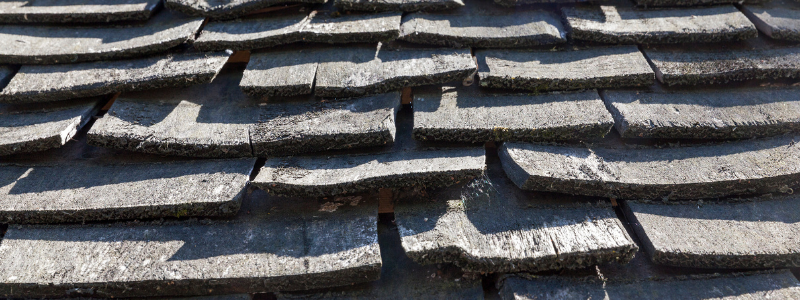
Worn or Missing Shingles
No matter what the house looks like, if you notice that there are missing shingles along the roof, large spaces where moss is growing over the shingles, sagging, or stains along with the ceiling and interior walls, you should walk away.
Each one of those problems can be dealt with. But, more often than not, the cost of repairing those problems is significant and, in the end, not worth the money, when buying a house with a 20-year-old roof.
Depending on the significance of those problems, you may end up having to replace the roof in its entirety, before you’re even able to enjoy the comfort of the home.
Your Homeowners Insurance Policy
Even though home insurance will cover – depending on the policy – roof repairs and replacements, there are a lot of home insurance policies that won’t cover roofs over twenty years old. Most of these policies work in one of two ways; they either won’t write a new policy for a roof that is over twenty years old or, for you to keep your old policy, they require the twenty-year-old roof to be replaced.
The attributes mentioned earlier are what to look for so that you know when to walk away. But, there are a few attributes to look for that indicate the roof you are looking at, even though it is old, remains strong and sturdy. These attributes include things like all of the shingles being present, the roof being perfectly even, clean and sturdy gutters; among various other things.
If you notice these attributes, then that’s a great sign, as it means the roof has been well-taken care of and should last for a while. But, that doesn’t necessarily mean repairs won’t be necessary, either now or in the relatively near future.
The Lifespan Of A Typical Residential Roof
A typical residential roof is meant to last for a specific period of time. But, this specific period of time varies from roof-to-roof, depending on the materials that the residential roof is made of. Being aware of the lifespan that certain roofs offer makes it easy to determine when your new house’s roof – or any roof, for that matter – will need to be replaced.
Every residential roof is meant to last for a certain amount of time. The exact amount of time that a particular residential roof is meant to last for depends entirely on the materials it is made of. Because of this, there are some roofs that can easily last for thirty years, and some that will fall apart long before that.
When buying a house with a 20-year-old roof, take into consideration what materials make up the roof of your potential new home.
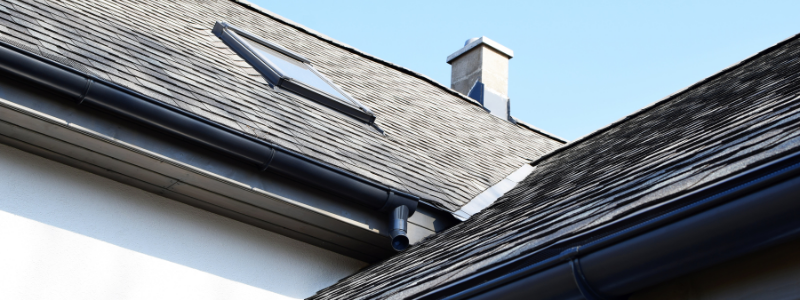
Asphalt Shingle Roofs
Most residential roofs make use of asphalt shingles. The reasons for this are quite simple: asphalt shingles are very affordable, and they often come with good warranties. More often than not, an asphalt shingle residential roof is meant to last for fifteen-to-thirty years. But architectural shingles, which are, essentially, enhanced asphalt shingles, can last for twenty-five-to-thirty years.
Other Material Roofs
Some of the more long-lasting materials are tile, slate, and copper. Roofs that make use of those materials can easily last for up to fifty years. Many other metal materials can last for fifty years, or a lot longer, depending on their overall quality.
If it’s asphalt shingles, you should expect a complete roof replacement. If it’s slate, metal, or other materials, you may have some extra time before a replacement is needed, but repairs may still be necessary.
B&M Roof Inspections
Regardless of the material that your residential roof is made of, though, B&M Roofing is here to help. By contacting us today, you can organize an inspection. Even before buying a house with a 20-year-old roof.
During this inspection, we will consider any flaws that your new home’s roof possesses, then we will tell you the repairs that are necessary, and perform those repairs. That way, no matter what it’s made of or how old it is, your roof will be in tip-top shape.
When To Get A Roof Inspection
The importance of your home’s roof cannot be overstated. A sturdy and strong roof is your home’s first defense against the elements. The key to a healthy roof is to know when to get a roof inspection.
To ensure that your roof is as sturdy and strong as it can be, having your roof inspected on a regular basis is our best advice. By having your roof inspected regularly, you will learn if your roof has any problems, and then you will be able to fix those problems, ensuring that your home remains protected from the elements.
What Is A Roof Inspection?
A roof inspection consists of two separate inspections – a thorough inspection of your exterior roof surface and a thorough inspection of your interior roof surface. By inspecting those two elements of your roof, a roof inspector is able to determine the current quality of your roof, while also pinpointing any problems that must be dealt with.
A roof inspection is, just as the name implies, an inspection of your roof. But a proper roof inspection is more than just a quick glance at your roof – a proper roof inspection consists of inspecting the exterior of your roof and the interior of your roof. By performing those two inspections, you are able to determine the current state of your roof, while also pinpointing any problems that must be dealt with.
Exterior Roof Inspection
An exterior roof inspection consists of inspecting the roof’s surface and basic structure. It also includes inspecting the perimeter of the property, including siding, gutters, air conditioning units, and more.
To perform an exterior roof inspection you must go onto the roof and examine things like:
- Shingles
- Flashing
- Gutters,
- Roof planes
That way, you can see if there are any broken shingles, cracks, leakages, damaged gutters, or ice dams.
Interior Roof Inspection
Right after the exterior roof inspection, you must perform an interior roof inspection.
To do this, you will need to go into your home’s attic and examine the insulation, ventilation system, and current state of the ceiling. Doing so allows you to make sure those facets of your roof are in tip-top shape, ensuring that things like mold growth or decayed roofing are present.

Why Are Roof Inspections Important?
A roof, for it to remain capable of protecting your home from the elements, must be in tip-top shape. It’s the first defense of your home, loved ones, and your belongings. For your roof to be in tip-top shape, it must not have any significant problems that can lead to the degradation of the roof and its inability to protect the interior of your home. To ensure that your roof does not have those problems and that if it does they are dealt with as soon as possible, regular roof inspections are of the utmost importance.
Colorado Weather Can Be Harsh
Everyone who lives in Colorado knows that Colorado is one of the most beautiful states in the country. Everyone who lives in Colorado also knows that Colorado is no stranger to bouts of exceptionally intense weather. All of the rain, wind, snow, and ice that Colorado experiences can have a significant effect on the quality and durability of your roof.
To ensure that Colorado’s elements do not affect your roof too much and that whatever problems they cause are dealt with as soon as possible, your roof must be inspected. A roof inspection will allow you to understand the current state of your roof, and whether or not there are any problems that must be dealt with. By knowing the current state of your roof, and knowing whether there are any problems to take care of, you are able to keep your roof in tip-top shape.
Many of the more significant roof problems reveal themselves slowly.
Prevent Other Roof Problems
During the Winter season, for example, it isn’t uncommon for ice dams to form on your roof. When an ice dam has formed, the water on your roof is unable to fall away, forcing it to leak into your home.
This may not be noticed, at first, but eventually, this water will build up and cause significant damage to:
- Roof
- Siding
- Ceilings
- Attic
- Walls
Since these problems reveal themselves slowly, it is important to have your roof inspected regularly, even if there doesn’t appear to be any problems. The problems that may be present will likely only get worse, and it’s considerably cheaper to remove an ice dam and replace some rotten shingles than it is to replace your entire roof, the ceilings in your attic, and various walls in your home.
When Should You Get A Roof Inspection?
According to The National Roofing Contractors Association, you should have your roof inspected during both fall and spring, as well as after any significant weather event. By having your roof inspected during those seasons, as well as after those events, you are able to notice any significant damages when they occur, allowing you to deal with them promptly.
The National Roofing Contractors Association recommends having your roof inspected at least twice a year; during fall and spring. Those two seasons, in particular, are the safest for both roof inspections and roof repairs. Inspecting your roof during the winter, especially in Colorado, may be dangerous.
Along with that, The National Roofing Contractors Association also recommends having your roof inspected after any significant weather event. A snowstorm, for example, can cause plenty of damage to your roof, so it’s a good idea to get your roof inspected right after the storm has passed.
A roof inspection for both Fall and Spring – two roof inspections annually – allows your roof to be inspected safely and thoroughly. Any damage that’s found on your roof can then be dealt with, during those seasons. Every time a significant weather event takes place, it’s a good idea to have your roof inspected. That way, you are able to check the state of your roof and take care of any problems that your roof may be an experience
Even though you can inspect your roof on your own, it’s almost always a good idea to hire a professional. A professional roof inspector knows how to traverse roofs of all sorts safely, and they also know how to inspect each and every facet of your roof. Because of this, when a professional roof inspector is finished inspecting your roof, they will know exactly what’s wrong – and what’s right, for that matter – with your roof. But, if you inspect your roof on your own, without any prior knowledge or experience, it’s likely that you may miss certain facets of your roof that need to be examined more closely and thoroughly.

- The National Roofing Contractors Association recommends having your roof inspected one during Fall and once during Spring
- The National Roofing Contractors Association also recommends having your roof inspected after any significant weather event
- Fall and Spring are the safest and easiest seasons to have your roof inspected, especially in Colorado, due to the comparatively mild weather and safer weather conditions
- Hiring a professional roof inspector is almost always a good idea,
- A professional roof inspector knows how to traverse your roof in a safe manner
- A professional roof inspector will know how to examine every facet of your roof closely and thoroughly, ensuring that no problems or potential problems are missed
- B&M Roofing offers roof inspection services, you can get in touch with us today to get an inspector and a free estimate for any repairs or replacements that may be necessary
B&M Roofing offers roof inspection services. By getting in touch with us using this form, we will come to your home, inspect your roof, and then give you our estimate regarding any repairs or replacements that are necessary!
Winterizing Your Roof
Fall is here, which means plenty of leaves to clean up, sprinklers to shut off/blow out, and tons of other chores to do around the yard and home. This time of year is also a great time to repair or replace your roof. If you don’t need any repairs or a roof replacement, then winterizing your roof is the next fall task you should have completed before the weather really starts to turn against your favor.
With the first freeze of the year usually happening in fall, it’s a good time to start thinking about how to best prepare for the winter. Just as you would ‘winterize’ things like pipes, boats, tires, pools, and lawns, we recommend you include your roof on that list, as well. Taking some preventative and proactive measures now to protect your roof can save you a good chunk of change in the future.
It’s important to note that this checklist could probably also be used in the springtime, to prepare for the warmer months, as well. The benefit of doing that is that you’ll keep your home safe from the harsh, outside elements year-round. Weatherizing your roof will also keep your home insulated, thus lowering your energy costs.
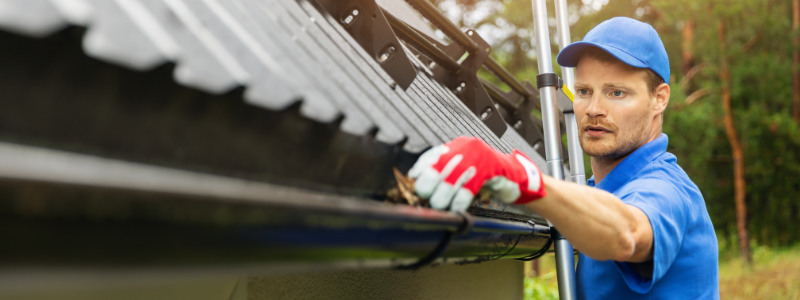
Winterizing Your Roof Checklist
While it’s best to have a professional roofer come inspect your home and do any necessary repairs, there are just some things you can do as a homeowner to prepare yourself and your home for the cold, harsh weather that approaches.
We’ve developed a checklist that you can follow to start winterizing your roof today:
☐Look for damage
Simply inspect your roof for warping, missing shingles, and debris. Look for damage to your gutters, flashing, and any vents or skylights. Finding any damage in these areas means you could have damage to your shingles, too. Catching problems early on can save you time and money in the future.
☐Clean and test your gutters and downspouts
Without the proper drainage system, your roof can collapse or suffer from extensive water damage. Make sure to inspect your gutters and downspouts thoroughly for holes and cracks and remove any debris. After you’re done removing debris, run some water through the gutters to ensure they’re draining properly.
☐Trim your tree branches
Falling tree limbs are a major threat to your roof during the winter. With heavy wind and snow, trees and limbs can easily break off and damage other things around them. If you have any trees around your home, inspect for branches that are hanging over or touching your roof. Trim these branches before winter sets in to save your roof from being damaged by falling limbs.
☐Insulate & ventilate your attic
Insulating and ventilating your attic is a key step to protecting your roof during the winter. As little as one to two inches of snow can create ice dams, which can damage the foundation of your roof. Install insulation on the plywood or drywall of your attic. Make sure to seal any areas where heat can escape. Proper ventilation will also help prevent snow from refreezing and causing moisture damage.
☐Inspect caulking & flashing
Check for wrinkled and cracked caulking and replace it if necessary. If the area is a safe place to do repairs, simply reapply the caulk (waterproof caulking, used for bathrooms is perfectly fine). Secure any loose flashing and replace any that are damaged. Pay close attention to areas around the chimney, vents, and other protruding additions to the roof.
☐Clean your chimney
Because your chimney will be getting some extra use during the colder months, it’s important to inspect and clean your chimney annually. Regular cleanings can prevent fires and protect your roof from damage. There may also be critters living in your chimney, which can spell disaster for your roof.
☐Invest in snow guards
Installing snow guards this winter will protect your gutters, vents, cars, and family from roof avalanches. Snow guards catch heavy snow before it falls from your roof. They allow it to melt before it falls to the ground. Investing in snow guards is inexpensive and will prevent damage to the areas on and below your roof.
☐Be aware of pests
Pests can cause a tremendous amount of damage to your roof. Keep an eye out for squirrels, birds, mice, and other animals who may seek shelter on your roof during the colder months. Hire a pest control to get rid of them as soon as possible. Different types of critters can manipulate the roof to accommodate their needs, but not yours. You may see signs of eaten shingles, bitten off to create space for their homes, or holes around flashing, etc.
☐Cover mechanical equipment
Any mechanical equipment on your roof like plumbing vents or swamp coolers should be covered to prevent water damage. Just like your grill or air conditioner needs to be covered, any mechanical equipment on your roof will need the same type of care. This will ensure that it performs at optimal efficiency and isn’t compromised by the harsh weather and elements.
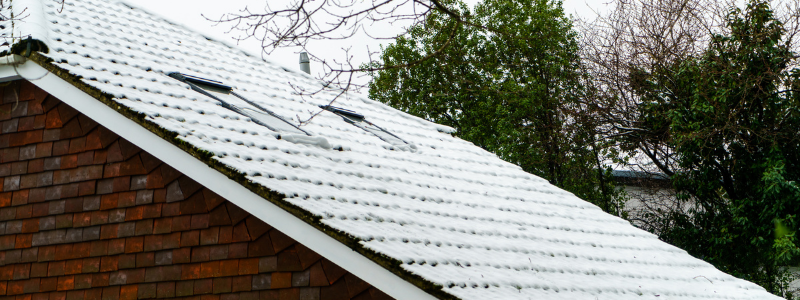
No, winterizing your roof may not be the most exciting part of the fall season, but it can save you time and money in the future. We promise it’s more fun than having to repair damages inside the home or replace your entire roof. It may seem like a large chore, but following this checklist will actually go pretty quickly, and save you more time and money in the future.
By following this checklist and taking simple, precautionary measures, you can protect your roof from the damages of wind, snow, and ice this winter.
If any problems arise from inspecting and winterizing your roof on your own, B&M Roofing experts are ready and happy to assist. Our roofing experts work hard in not simply dealing with roof problems, but helping find the cause of all damage-related issues and repairing them. Whether it’s a simple repair or total roof replacement, our proactive and detailed response to roof damage issues will restore your home as well as your faith in roofing contractors.
Importance of Roof Inspections
Your home’s roof may not always be top-of-mind, especially when it comes to around-the-house maintenance or a “honey-do” list. There are so many other things that require your attention, like that new deck you have designed, the garden area, perhaps new sod, or remodeling a bathroom or kitchen. However, when it comes to protecting the investment in your home, we’d argue that your roof is the single most important part of your house. When your roof is damaged or compromised, it can cause major damage to the rest of the home. That’s why we emphasize the importance of roof inspections – regular maintenance and inspections can help detect damage and even prevent further damage from happening to your home.
Perhaps you do keep up on roof maintenance, but as Colorado’s weather can be hard on the roof, you have concerns about how your roof is holding up following a hail storm or harsh winter. While you can assess major damage on your own, a professional roof inspector provides insight and expertise that most homeowners can’t muster.

What Is the Importance of Roof Inspections?
Just like it’s great to have routine inspections on your car, your teeth, eyes, and just about anything else, roof inspections are important in understanding the condition of your roof.
Roof inspections can help point out your roof’s:
- Age
- History
- Weaknesses
- Strengths
- Awkward shapes
- What type of shingle may be best for your roof
Knowing and understanding these things about your roof can help prolong its lifespan and durability. Roof inspectors will then be able to recommend the right type of repairs or whether a replacement is needed. The importance of roof inspections is equal to the amount of money you spend on your roof.
Either you have minor maintenance and routine inspections or you’ll have major repairs and roof replacements. That’s also why a professional roofer should be routinely inspecting your home’s roof.
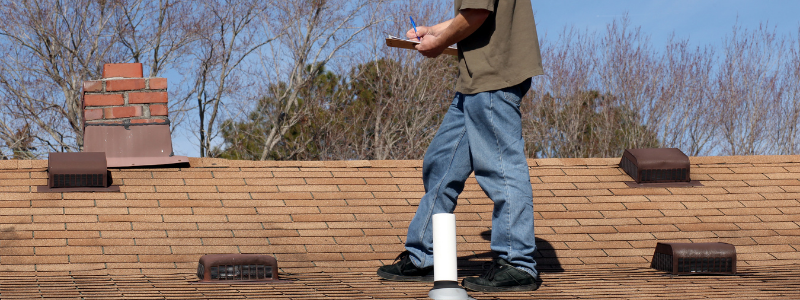
What Do Professional Roof Inspectors Look For?
Following a major storm, you may feel inclined to try and save money and inspect the roof yourself. While we don’t discourage this, we do not recommend you get up on the roof to do so. Of course, you can take a survey of your roof from the ground, but not always do homeowners know what to look for. If you spot nothing but still have concerns, it’s time to call a professional roof inspector. You’ll benefit from their professional insight.
Professional roofers will also usually start with a quick survey of your roof’s health from the ground. Using our own equipment, we look for the obvious signs of distress (and they know what they’re looking for): missing shingles, changes in color, ripped shingles, major damage caused by falling branches.
When inspecting your roofs, a professional roofer will perform a few things, depending on the health and condition of the roof.
Surface assessment
- Hail damage may be hard to spot, and experts know how to evaluate the remaining lifespan of shingles, grain levels and locate hail-strike damage. Experts will also look for discolored, warped, or missing shingles, as that’s an early sign there may be water damage. Any debris on the roof may have caused a shingle to come loose, as well.
Ventilation
- Keeping air moving through your attic is important, and experts can quickly assess if vents are working to the capacity your home requires. Roofers will inspect all roofing vents, insulation, and other roofing materials that help assist in proper roof ventilation.
Insurance claims
- If your roof is damaged, you’ll need a professional to itemize and properly describe the damage. An expert may ask for a history of past insurance claims if there are any. Professional roofers will also guide you through each step of an insurance claim and keep you well-informed
Structural survey
- It’s even more difficult to see the damage under shingles than spot superficial damage. If your roof is losing structural integrity, it can lead to larger problems down the line. Identifying these issues and addressing them is critical.
Safety First:
- It’s always best to leave the professionals to climbing ladders and walking on a sloped roof, so please don’t risk your health self-inspecting. Expert roofers will have the proper equipment and training to know how to maneuver around your roof.
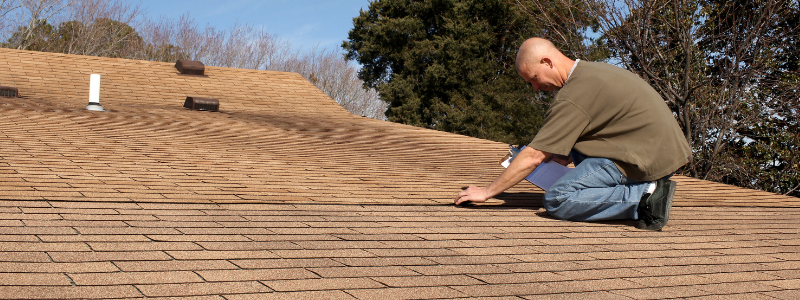
How Often Should Roofs Be Inspected?
Roofs are made to last anywhere from 20 to 50 years. The more proactive a homeowner is with maintenance and inspections, the longer the roof will last. Hence the importance of roof inspections – a small investment into a routine inspection will save you money in the long run.
So, just how frequent is “routine?” Generally speaking, we recommend a professional roof inspection at least once a year, if not twice. The best times to get your roof inspected are in the spring and summer months, right before harsher weather approaches (hail in the summer and snow in the winter).
In Colorado, roof inspections are especially important. Between the sun, hot, dry air, hail, rain (the very little these days), and snow, roofs take quite the punishment from the harsh, extreme weather. The more proactive you can be with roof inspections, the better off your roof – and consequently, your home – will be.
Colorado’s Professional Roof Inspectors
B&M Roofing of Colorado provides free, no-obligation professional roof inspections to homeowners in Denver and Boulder.
As native Coloradans, we’ve seen our fair share of damaged roofs. We know what weathered, old, or damaged roofs look like – as well as healthy, functioning roofs. If, when we are called for a roof inspection, we can save you money, we will. We’ll only give you our exact recommendations. If you only need repairs after an inspection, we’ll say so. If you don’t need any repairs at all, we will also tell you that. Even the smallest signs of wear and tear, we’ll inform you and give you options on how to proceed.
As professional roofers, it’s not about the roof – it’s about protecting you and your home.
Request a visit from our inspection team with our online form, or by calling 303.443.5843.
How to Stop a Roof Leak Temporarily
At B&M Roofing of Colorado, we understand that figuring out how to stop a roof leak can be a homeowner’s worst nightmare. Watching water seep through your roof and cause damage to your home can be incredibly stressful, especially while waiting for emergency roof repairs. That’s why we offer prompt emergency roof service requests to address your needs quickly.
In the meantime, we want to help you minimize further structural damage while you await our crew’s arrival. Here are some temporary measures you can take to manage a roof leak until we can perform more permanent repairs. Your home’s safety and protection are our top priorities, and we’re here to support you through this challenging situation.
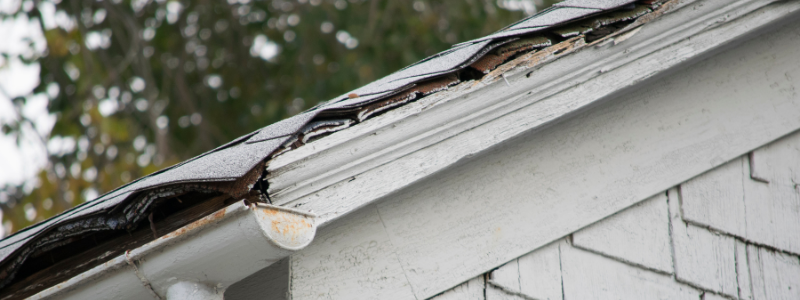
Common Signs of a Leaky Roof
Identifying a leaky roof can be crucial to maintaining the integrity of your home. There are several telltale signs that your roof may need repairs.
First, check for water stains on the ceilings or walls inside your home. These yellowish-brown spots often suggest that water is seeping through the roof and can indicate a developing issue that needs immediate attention. Another sign to look out for is missing, cracked, or curled exterior shingles. A damaged roof can allow moisture to penetrate, leading to leaks. Walk around your house or use binoculars from a safe distance to inspect the shingles closely.
Pay attention to any unusual drafts or increased energy bills. If your roof is not effectively insulating your home, it can lead to higher heating and cooling costs. Additionally, notice any signs of mold or mildew, particularly in the attic or near the roofline. These fungal growths thrive in damp conditions and can clearly indicate water intrusion. Finally, after heavy rain or snow, check your gutters and downspouts. If water is overflowing or pooling around the foundation, it could mean your roof drainage system is compromised, possibly due to leaks.
By being on the lookout for these signs, you can proactively address any potential roofing issues before they escalate into more significant problems. Regular inspections and maintenance are key to prolonging the life of your roof and protecting your home. Identifying a leaky roof can be crucial to maintaining the integrity of your home. There are several telltale signs that your roof may need repairs.
These are just some of the most common areas to look for roof leaks, but there are more tell-tale signs of missing shingles, mold or mildew, rotted wood, and discoloring on the ceiling side of your home.
Temporary Leaking Roof Repair
At B&M Roofing, we understand that water naturally flows downhill, and often, the lowest point for drainage can be located above your ceiling. To effectively manage drainage and reduce the risk of water damage in your attic, it’s crucial to identify the wettest area of your roof, which may appear as a bulge if the leak has been neglected for some time.
By carefully puncturing this bulge with a finish nail or a similar small tool, you create a pathway for the trapped water to escape into a bucket below. This proactive step can significantly alleviate water damage and is much more manageable than the extensive repairs required for a severely water-damaged ceiling—Trust B&M Roofing to provide effective solutions for your roofing needs and prevent further damage to your home.

Locating the Roof Leak
At B&M Roofing of Colorado, we know that the most challenging part of addressing a leaky roof is pinpointing the source of the leak. Once you’ve identified the leak, finding a temporary fix becomes much simpler.
If you’re comfortable, we recommend inspecting your attic to check the roof deck, which is the underside of your roof. Leaks often originate from joints between plywood. It’s important to note that the leak may not be located directly above or below where you observe the water damage.
If the leak isn’t immediately visible, we have an effective method to help you locate it, though caution is key. Water can travel along your roof before it starts to show in your ceiling, so it’s crucial to find the source of the leak before it leads to extensive damage. The best time to search for a leak is when there’s water running on your roof.
Don’t wait for a heavy rainstorm to cause significant water damage. Instead, control the water flow using a garden hose on the roof. A small amount of water in targeted areas can help you locate leaks. Ideally, have someone else in the attic with a flashlight to spot any moisture – the water will reflect the light, making the leak easier to see.
If you don’t have access to an attic, you can look for clues by pouring water on areas like flashing, ridge caps, roof valleys, and gutters or downspouts. If possible, set up a bucket in your attic to catch dripping water and prevent further damage to your home.
Remember that patching a leak from the underside of the roof deck using tar, shingles, or plywood is only a temporary solution. It’s crucial to address water intrusion promptly to prevent additional property damage.

Get Started With Expert Roofing Services Today!
At B&M Roofing of Colorado, we understand that knowing how to fix a leaking roof temporarily can cause significant stress and more extensive damage if not addressed promptly. That’s why we prioritize immediate response for our customers. Our dedicated emergency response teams are always on standby, equipped, and ready to tackle leaking roofs whenever and wherever you need us.
If you’re facing a roofing emergency, you can rely on our expertise to provide swift and practical solutions. Don’t let a slight leak become a significant issue—reach out to us without hesitation. Contact us today or conveniently fill out our emergency service request form on our website. Our experienced team is here to ensure your home is protected and safe—Trust B&M Roofing to be your dependable partner in preserving the integrity of your roof.
Tar And Gravel Roof Removal
For a durable flat roof, you can’t go wrong with tar and gravel. Tar and gravel roofs are affordable, exceptionally durable, and long-lasting. But, even though tar and gravel roofs are excellent, there are several reasons as to why someone might want to and should remove them.
What Are Tar And Gravel Roofs?
A tar and gravel roof is a roof that consists of asphalt sheets, hot tar, and roofing felt. Together, these elements offer excellent roof protection and enhanced durability for both the roof and the home/business that the roof is protecting. Every single tar and gravel roof consists of multiple layers, each one containing those exact same materials. Right on top of a tar and gravel roof, there is a small layer of gravel, which protects the bottom layers from excessive sun and moisture while also holding those layers together.
- A tar and gravel roof is a roof that consists of asphalt sheets, hot tar, and roofing felt
- Every tar and gravel roof consists of multiple layers and the top layer is gravel
- By having this gravel on top, the roof is held together and the gravel can protect the bottom layers from excessive sun and moisture
What Are The Advantages And Disadvantages Of Tar And Gravel Roofs?
Every year, Colorado experiences a significant amount of snow and a decent amount of rain – around 300-days of sunshine, 17-inches of rain, and anywhere from 60-to-100-inches of snow, as per the statewide annual average. Both of these elements can easily seep into an unprotected flat roof and damage the interior of the property that the roof is protecting.
But, with a tar and gravel roof, it is much more difficult for the elements to damage the interior of a property. More and more homes and businesses are using flat roofs, but in order to ensure those flat roofs are protected, the flat roofs must be made of strong and durable materials. Tar and gravel roofs are ideal for that since they offer a wide variety of protective measures that keep the elements out of a home/business.
Advantage – Durability
Tar and gravel roofs are exceptionally solid and, due to their multi-layered nature, they are extremely dense. Because of these qualities, tar and gravel roofs are capable of preventing excessive moisture from flowing through the roof and into the interior of a home/business. But, it is worth noting that, in the areas of Colorado where there is an extreme amount of snow and rain – the mountains, for example – tar and gravel roofs can fall apart far more quickly.
Advantage – UV Protection
To go along with that, tar and gravel roofs offer excellent UV protection. This UV protection allows tar and gravel roofs to last for multiple decades because the sun doesn’t cause the materials that comprise the roof to actively break down and decay.
Advantage – Affordability
Even though most flat roofs tend to be pricey, tar and gravel roofs are very affordable. Due to this affordability, tar and gravel roofs are excellent for homeowners and business owners who need a strong, durable, and long-lasting flat roof, but don’t have the money to spend on, for example, a PVC flat roof.
Disadvantage – Improper Installation
The most notable disadvantage of owning a tar and gravel roof is that, if they are improperly installed, they can easily lead to significant damage. For example, if the hot tar isn’t applied properly, it can burst into flames and destroy an entire property. Even if the hot tar is applied in the proper manner, if the individual layers aren’t connected properly, significant leakage issues can follow.
Those are just two examples of what the improper installation of a tar and gravel roof can lead to. But, beyond those problems, tar and gravel roofs are simply quite difficult to install and very heavy, which can be inconvenient to deal with.
- Every year, Colorado experiences a lot of snow and rain
- Most flat roofs require extra protective measures to protect against that snow and rain since water can be trapped on a flat roof
- Tar and gravel roofs offer that protection since they consist of multiple layers, all of which are very durable
- To go along with that, tar and gravel roofs are a great fire retardant and they protect against UV rays, which allows them to last for many decades
- If a tar and gravel roof is improperly installed, it can lead to very significant problems
- Problems such as the hot tar bursting into flames and significant leakage issues
- Beyond that, tar and gravel roofs are very difficult to install and very heavy, which can be very inconvenient to deal with

Why Should Tar And Gravel Roofs Be Removed?
A tar and gravel roof is only meant to last for around 20-to-30-years. Once that point has been reached, it’s time for a tar and gravel roof removal. That is one of the most common reasons for a tar and gravel roof being removed. But, along with that, tar and gravel roofs may also need to be removed due to having been improperly installed, experiencing too much sun and moisture damage, or being unsuited for the needs of a particular property.
Even though tar and gravel roofs are very strong, they are only meant to last for around 20-to-30-years. Once they’ve reached that point, tar and gravel roof removal is the best choice, as the roof is no longer able to protect the interior of the property from the elements.
As mentioned earlier, if a tar and gravel roof is improperly installed, it can lead to significant issues. Significant issues such as the hot tar bursting into flames, and damaging the entirety of the property, or excessive leakages. If a tar and gravel roof is improperly installed, then it must be removed.
More often than not, even in places where there is heavy rain and snow, tar and gravel roofs will hold up quite well. But, if that rain and snow don’t have anywhere to go, and stays on the roof for too long, this can lead to roof depressions, which are sunken areas of the roof that have experienced too much moisture. These can be filled in, but if there are too many of them, or if new depressions are created on a frequent basis, then the tar and gravel roof is unsuited for the needs of that particular place and it should be removed and replaced.
- Tar and gravel roofs are strong, but they are only meant to last for 20-to-30-years; past that point, and they need to be replaced
- If a tar and gravel roof is improperly installed, it must be removed, because it can cause significant damage to the rest of the roof and the property
- Even though tar and gravel roofs can be quite useful in places with heavy snow and rain, certain problems can easily arise
- Problems such as depressions being created along portions of the roof and excess moisture being on the roof for too long
- If there are too many depressions being created, and there’s already a good drainage system, then that means the roof is unable to meet the needs of that particular place and should be removed and replaced
What Does It Take To Remove A Tar And Gravel Roof?
Tar and gravel roof removal is often long and difficult, due to the density and durability of tar and gravel roofs, yet not particularly complicated. Replacing the tar and gravel roof is far more challenging and consists of many more variables, which is why it’s best left to professionals.
For proper tar and gravel roof removal, a roofing tear-off shovel, carbide roofing cutter, and pry bar are all necessary. By having these tools, the upper layers of the tar and gravel roof can be removed, the individual layers of the roof can be sliced into, and then those layers can be pried off.
Even though the process isn’t particularly complicated, it is difficult and it can be unsafe. Because of that, if you aren’t sure what to do, hiring a professional is the best choice. And, when it comes to installing a new roof, hiring a professional is always the safest, easiest, and best choice.
Professional Tar and Gravel Roof Removal
By working with B&M Roofing, we will help you determine what your roofing and budgetary needs are, what is right for your roofing and budgetary needs, and what roof will best fulfill those needs. The installed roof will be strong, sturdy, and completely safe.
- Tar and gravel roof removal is often long and difficult, but not complicated
- All you really need is a roofing tear-off shovel, carbide roofing cutter, and a pry bar
- By having those three tools, you can remove the upper layers of the roof, slice into the bottom layers, and pry those layers off
- Hiring a professional for that process is often the best choice if you don’t know what you are doing
- For replacing that roof, hiring a professional is the best choice because it is the safest and easiest choice
By hiring B&M Roofing, we will work with you on determining your budgetary and roofing needs and then fulfilling those needs in the best way possible.
30 Year Roof Shingles
Today, you can find roof shingles that are designed to last for specific periods of time. Periods of time such as 15 years, 20 years, and 30 years, among others. Right now, 30-year roof shingles are quite popular due to costing less than longer-lasting roof shingles, while also lasting a fairly long time, being made of strong materials, and being able to withstand Colorado’s intense weather.
What Are 30-Year Roof Shingles?
In today’s roofing market, there are many different roof shingles that you can purchase. Most of these roof shingles are designed to last for a very specific period of time. You can easily find roof shingles that are designed to last for 15 years, 20 years, and 30 years, among other shingles that last even longer lengths of time. Each one of these roof shingles is designed a little differently, due to the materials that they use, their length, and the durability that they offer.
It is no secret that a new roof – or even just roof maintenance and repairs – are relatively expensive. It is also no secret that due to Colorado’s frequent bouts of intense weather, roof repairs and replacements are not uncommon.
Right now, there is a wide variety of different roof shingles that you can purchase. Most of these roof shingles are designed to last for a specific period of time. Each one of these roof shingles is designed to last for the exact amount of time that they advertise, and to do this, they are often thicker than shingles designed to last for less time and they are also made of slightly different materials.
Just as the name implies, then, they are ones that are designed to last for 30-years. Since they are designed to last for 30-years, they are thicker and stronger than other roof shingles. This not only allows the roof shingles to last longer, but it also makes common forms of weather damage – snow and ice roof damage is quite common in Colorado – which, of course, allows your roof to last for longer while reducing the need for repairs.
- Roof maintenance and repairs aren’t always cheap
- Colorado experiences frequent bouts of intense weather, leading to the necessity for roof repairs and replacements
- There are a wide variety of different roof shingles that can be purchased, these roof shingles are often designed to last for specific periods of time
- Some of the most popular roof shingles are 30-year roof shingles
- They are durable – designed to last for 30 years; they are thicker and stronger than other roof shingles, allowing them to last longer and to protect roofs against Colorado’s intense weather

What Sets Them Apart From Other Shingles?
If you compare them to, for example, 15-year roof shingles, you will notice a few differences. None of these differences is particularly large, or even that noticeable, but they transform the durability and stability of your roof. Because of this, 30-year roof shingles are stronger and sturdier than 15-year roof shingles.
The most notable quality that sets 30-year roof shingles apart from roof shingles that have been designed to last for shorter periods of time is their thickness. If you look at 15-year shingles, you will find that most of them are relatively thin with few layers. Most of them are strong enough to handle intense weather, and they can last for 15-years, but they aren’t thick enough to protect against especially intense weather or to last for much longer than 15-years. But, 30-year roof shingles can be twice the size of 15-year roof shingles due to their enhanced thickness.
To ensure that each layer is connected to one another in a sturdy manner, 30-year roof shingles use better adhesive and lots of it. Most 15-year roof shingles use good adhesive, as well, but they often use less of it and the durability of the adhesive is often not to the standard of a 30-year roof shingle.
For roof shingles to be sturdy and durable, they must use strong materials. More often than not, 30-year roof shingles use the same basic materials that 15-year roof shingles use. These are materials such as wood, asphalt, and slate; among various others. But, most 15-year roof shingles use recycled materials, whereas 30-year roof shingles use new materials. That way, the shingles that comprise the roof are stronger and sturdier. Plus, there is less filler within the shingle.
The last difference that must be considered is the price. Just as you would expect, 30-year roof shingles are more expensive than 15-year roof shingles. Much of this is due to the materials that comprise the shingles as well as their thickness and density. These factors lead to roofing shingles that cost more money, yet last longer than 15-year roof shingles and, generally speaking, serve as a great investment.
- The main difference that sets these apart from other roof shingles is the thickness
- They are much thicker than 15-year roof shingles, among others, and that’s because they have more roofing layers
- More adhesive is used than other roof shingles; that way, each layer of shingle is connected to one another
- 30-year roof shingles often use the same materials that other roof shingles use, but they use less recycled material and there’s less filler in each shingle
- The price of 30-year roof shingles is more than that of a 15-year roof shingle, due to the density and material
Are 30-Year Roof Shingles Right For You?
A roof is an investment, and this is especially true of the shingles that comprise the roof. If you do not wish to spend a lot of money and have no need for an especially-strong or long-lasting roof, then this type of shingles may not be very useful to you. If you would like your roof to last for many years, and you would like to minimize the need for roof repairs, then they may just be right for you.
A good roof is a significant investment. But, the dividends that this investment can pay off are often more than worth the initial costs.
When you invest in them, you get roof shingles that are strong, sturdy, and long-lasting. By doing this, you ensure that your roof will last for a long time, with minimal issues, and that the interior of your home is protected.
For many people, this makes 30-year roof shingles a great investment. But, they can be expensive, and if you are uncertain as to whether or not you will move, then they may not be a great choice because they affect very little of your home’s resale value.
The best way to determine whether or not 30-year roof shingles are right for you is to concern your needs and wants, as well as your budget.
Here, at B&M Roofing, we can help you ask and answer those questions. Then, when you’re ready for the new roof, we can help you build and install it!
Creased Shingles
In the state of Colorado, intense wind and heavy snow is a very common occurrence. Many Coloradans are equipped to handle drastic weather changes, but homes and businesses can sustain damage during hail, rain, or snow storms. These drastic weather patterns can cause costly repairs, including commercial and residential roof deterioration. Even small tears and bends can lead to leaks and once a leak has set in, it can cascade. In some instances, roof damage may not be extensive or even noticeable. However, for this reason, it’s important to get your roof regularly inspected. An experienced Colorado roof will be able to check for common signs of water stains, curling, and creased shingles. Creased shingles are a threat to the stability and durability of any roof. But, fortunately, they’re easy to spot and, with the help of B&M Roofing, easy to fix.

What Are Creased Shingles?
As the name implies, creased shingles are bends in asphalt shingle roofing material. More often than not, creases are one of the most visible signs of roofing deterioration. A damaged shingle, when inspected closely, will provide roofers information helpful to a Colorado roofing inspection or evaluation. Creasing usually occurs in intense wind storms. If the wind finds leverage within the roofing material, it can push shingles up and back down until it forms what is known as a crease. If this process happens repeatedly, a shingle may tear off completely, leaving the material beneath exposed and also vulnerable.
More often than not, the crease on the shingle will begin on one side of the shingle—the right or left—but won’t reach the other side of the shingle. The creasing itself will, most likely, take the form of a faint and slightly-jagged line. Some creased shingles, though, have far more apparent creases that are larger and a bit darker.
Who Do Creased Shingles Happen?
When the wind is moving at an intense speed, it isn’t uncommon for the shingles on a roof to become loose. If the wind is especially intense, it can cause the shingles on the roof to lift up and flap in the wind. As this takes place, there are two things that can happen. One of which is that the wind, due to its intensity, pushes the shingle upwards and creates a very visible crease in the asphalt material. The other is that the loose shingle pushes up against another shingle, and by pushing up against the shingle a crease is formed on more than one.

That said, there are other reasons creased shingles are an indication that something “more” might be happening with your commercial or home roof. While high winds are often the culprit of creased shingles, there are instances where other roofing elements might be impacting the health of a roof. As a whole, roofing systems—including the frame, underlayment, sealant, and ventilation systems—should be working together to keep a roof strong and intact. Creased shingles can also happen for the following reasons:
- A sealant is becoming unsealed due to age, product defect, or poor installation.
- Installing shingles late in the year, which prevents the sealant from softening in the warm sun and, thus, it cannot perform as a reliable adhesive.
- The sealant had dirt on it prior to the shingles being installed.
- High overdrive, underdrive, angled, or mislocated placement of a nail.
It’s important to work with an experienced Colorado roofing company that can provide roof installations that are meant to extend the lifetime of your roof.
Wind Can Damage a Residential Roof
Due to Colorado’s intense climate, intense winds are far from an uncommon experience. When there are intense winds, it isn’t uncommon for roof shingles to be lifted from off of the roof, while still attached, and to begin flapping in the wind.
If a roof shingle isn’t bonded to the roof correctly—or, alternatively, if the adhesive has broken down—the wind can move into the open spaces underneath the shingle. When wind moves into these open spaces, it can push the roof shingle upwards, leading to the aforementioned “flapping in the wind”. Flapping roof shingles may begin to bend. A crease can easily form when shingles are bending into unnatural positions or angles. Sometimes, though, the roof shingle doesn’t bend at an unnatural angle. Instead, it pushes up against the roof shingle that is directly below or above it. If it pushes up against this roof shingle with force, then this can cause two creases to be formed on two different roof shingles.
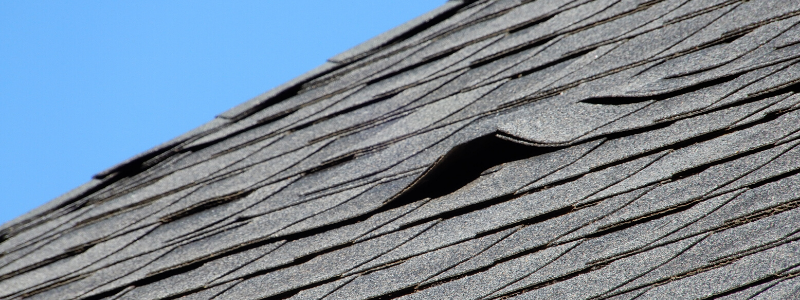
Why Are Creased Shingles Bad?
When your roof has a creased shingle, that means two things. One, it means that there is a pocket of space underneath the shingle that is open, which is how the air got underneath it and lifted the shingle up. Two, it means that your shingle is missing granules, due to the crease. Both of these are quite bad because they directly affect the stability of your roof and its ability to protect the interior of your property.
For a shingle to become creased, it must be lifted off of the roof. But, for this to happen, a strong wind must be able to go underneath the shingle. If there is a pocket of open space underneath the shingle, then a strong wind will be able to do this, causing the shingle to lift up.
When there is a pocket of open space underneath the shingle, it means that the shingle isn’t fully protecting the interior of your property. Things like rain, ice, and wind can flow into your property. If this isn’t taken care of, it can lead to some very significant damages.
As a shingle becomes creased – whether by being bent at an unnatural angle or pushing across another shingle – it loses granules. Granules from the entirety of shingle, and they protect the shingle from the sunlight. If there are fewer granules on the shingle, then that means that the shingle itself will begin to deteriorate, becoming far less effective at keeping the interior of your property safe.
What Is The Best Way To Fix Creased Shingles?
Creased shingles must be replaced and resealed before more damage can occur. Missing granules lessen the stability and safety of an asphalt shingles roofing system and, in turn, your roof and the interior of your property. Missing granules may also allow sunlight to shine down onto the shingle, and this can easily cause the shingle to rot and decay. If this happens, then rain, snow, and wind— and all elements that Colorado experiences frequently—can break through the shingle and wreak havoc on your home. This is something to avoid as it’s both costly and destructive to the inside and outside of the property.
While noticing creased shingles usually isn’t too difficult, replacing those shingles and applying the proper adhesive to them can be difficult. That’s why, at B&M Roofing, we offer services that are dedicated to locating the creased shingles on your roof and replacing them in the most affordable and effective manner possible! If you think you’re experiencing creased shingles on your Colorado roof, give us a call today at (303) 443-5843.
Roofing in the Rain
Mother nature can be unpredictable. Even with advancements in weather tracking and our daily consumption of weather forecasts, there’s no guarantee a rainstorm won’t strike. As a professional roofer, roofing in the rain is not an ideal setting. Reputable roofers across Colorado usually provide their due diligence when it comes to assessing and scheduling a new roofing job. Because the weather in the Centennial State can be volatile, preparation is key. Providers of Colorado residential roofing services should have a plan in place to handle extreme weather, especially if roof work is already underway.
In general, the ideal weather conditions for roofing are clear, warm days. Why? A home or commercial building can sustain water damage during roof replacement if rainy conditions are too frequent. It doesn’t mean it’s impossible to install a reliable roof in adverse conditions, just that more precaution and measures should be taken during inclement weather.
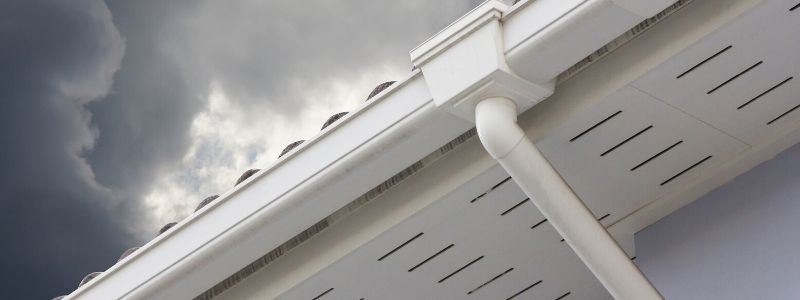
Rainstorms in Colorado
Colorado’s extreme weather is often a sore spot for many roofers. On one hand, B&M Roofing specializes in hail damage and repair, so we’re always adequately prepared for those fixes and scenarios. However, a damaged roof isn’t the only worry when roofing in the rain. Other issues that can occur such as rain create slippery conditions that make roof-work hazardous. The best bet is hiring an insured, safe roofer. If it starts to rain or drizzle, the roofers should act quickly to cover your OSB – most likely with a tarp.
Damage From Roofing in the Rain
What type of damage can be done when roofing in the rain? This is an important question because it may help to answer whether or not your roofing company is taking proper action to protect a new residential roof install.
Rainstorms can cause water damage to the roof decking. Roofs are framed with rafters or trusses and must be covered with sheathing or decking. Decking should be in place before other roof materials can be applied. The most common materials for this are oriented strand board (OSB) or plywood. The roof decking should never sustain water damage for the following reasons:
- Installing roof material over wet or wrinkled barrier (decking) is against roofing code in most areas
- Shingles will not adhere properly to wet roof decking like OSB
- Keeping water trapped in roof decking can cause the roof to eventually swell or buckle
- Trapped moisture can cause mold and mildew growth
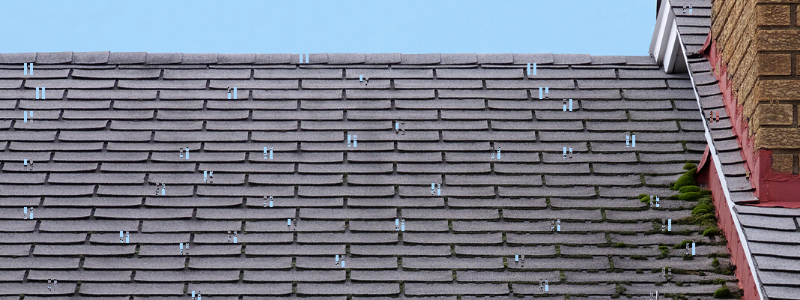
If a roofer has already started working on a new residential roof install and it happens to rain, they should act immediately. First, they should make every attempt to cover the roof decking and other exposed materials. A wet roof should:
- Dry properly, especially if it’s swelling
- Sanded or replaced altogether
When roof decking is wet, it can swell. If a roofing contractor were to lay roofing materials over wet decking, it could cause moisture to become trapped. Consider meeting with a roofing contractor prior to hiring as they should be able to explain various building codes in your area and disclose tactics to avoid roofing in the rain.
Roofing Warranties
What other impacts does roofing in the rain carry? If you didn’t already know, new roof installations usually (and should) come with two types of roofing warranties. A reputable company will provide details for both:
- Manufacturer Warranty
- Craftsmanship/Workmanship Warranty
Manufacturer warranties will guarantee the durability of the roofing material you’ve selected for your home. The warranty will usually vary by roofing type such as asphalt shingles, metal, tile, or shake and usually ranges from 25 to 50 years. However, a manufacturer does not guarantee the product warranty unless the roofing contractor adheres to set guidelines. For example, the manufacturer is not liable for damage that results from faulty workmanship. If a roofing installer decides to work under less-than-ideal weather conditions, such as rain, it could lead to your manufacturer voiding their warranty. Avoid bad workmanship at all costs!
Emergency Repairs in the Rain
If you’re experiencing leaks and damage during a rainstorm, don’t panic! While roofing services should avoid severe rainstorms, experienced roofers should have temporary fixes when a rainy day is unavoidable. Emergency roofing repairs should make immediate fixes to protect your home from extensive damage.
Note: Colorado is notorious for hail and rainstorms. Unfortunately, storms can wreak havoc on homes throughout Colorado state, costing thousands in damages and repairs. Storms also entice dishonest roofing contractors who are looking to scam panicked homeowners. An untrustworthy contractor may tell you that it’s okay to install shingles on a wet surface in order to get the job done quickly. Think twice before you hire roofers that appear to be in a rush. If it’s been raining, time is the only way to ensure damage control is met.

Avoid Roofing in the Rain
All in all, the best practice for any roofer is to avoid roofing in the rain. Considering the various issues that can occur, it’s worth it to take time to evaluate weather conditions and assess the time of year to consider a roof replacement. That said, there are many instances where the rain is unavoidable and unpredictable. In these instances, be sure you’re working with a roof that considers all possibilities and has a dedicated backup plan in the event of inclement weather. Steps should be taken to protect existing materials and completed work. Delaying a repair or replacement for a few days is well worth the wait. Rain can be extremely unforgiving, but the good news is, it won’t last forever.
Considering a new roof replacement? Contact B&M Roofing in Colorado. As a highly reputable company, we offer a variety of services for commercial and residential properties throughout the state. We can help you decide the best materials and we’ll be forthright with our process and planning. Contact us directly at (303) 443-5843.
How Often Should I Have My Roof Inspected
Every roof is a little bit different. Because of that, it isn’t always easy to say when, exactly, a specific roof should be expected. That’s why there are specific guidelines and recommendations that have been developed, over the years, regarding how often your roof should be inspected and the kinds of factors that will greatly affect your roof. Being aware of these guidelines and factors will make it easier for you to maintain the quality of your roof, while also knowing when its time for your roof to have a professional inspection. Find out below: how often should I have my roof inspected?
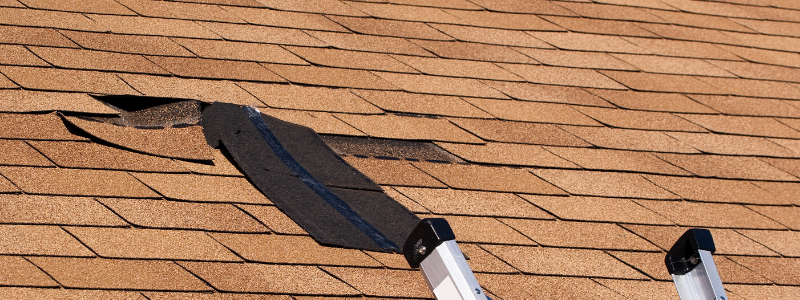
What Affects Your Roof?
The quality and stability of your roof are affected by a wide variety of different factors. The most important factors, though, are the ones that relate to the weather. Factors such as rain, hail, snow, and the sun. Each one of these different factors will affect the quality and stability of your roof in various ways.
Every year, Colorado experiences a fair amount of rain, a decent amount of hail, a lot of snow, and plenty of sun. Because of that, most residential and commercial roofs are capable of handling those elements. But, this certainly doesn’t negate the fact that those elements can have a significant impact on the quality and stability of your roof.
If there’s a significant amount of rain, it isn’t uncommon for the shingles on that roof to absorb the moisture. When this happens, it’s inevitable that the shingles will weaken, which leads to those shingles falling off. If that doesn’t happen, though, too much rain can also lead to the shingles rotting, which means they take longer to fall or create mold. Mold is especially bad as it can degrade not just that shingle, but the entirety of your roof.
More often than not, heavy rain isn’t a significant issue. But, hail can lead to very big problems that affect your roof in a variety of less-than-pleasant ways. In fact, Colorado usually experiences three-to-four catastrophic hail storms every year, and each one of these hail storms often leads to over $25 million dollars in insured damage. The reason for this is that hail is quite strong, and it comes down at a quick pace. This can lead to gutters being dented and cracked open. But, it can also lead to entire shingles breaking down, or the granules that comprise the shingle falling off. If any of those things take place, it isn’t unlikely that the entire roof would begin to fall apart.

Since Colorado experiences so much snow, snow-related roof damage is incredibly common. Usually, snow-related roof damage occurs due to one of three things. If there is too much snow on a roof, it can lead to that roof collapsing. If there is a lot of snow on a roof, when that snow melts and then freezes again, it will expand and damage the foundation of the roof along with a large portion of the roof. If the roof isn’t particularly stable or dense, then all of that melted snow can flow through the ceiling and into your home, leading to cracks in your roof, damaged walls, and other issues.
The sun has a significant effect on your roof, but this effect often takes place over time. As the sun’s rays shine down on a roof, the roofing material expands, and then it contracts as the sunsets. This can lead to the roof becoming less and less stable, leading to leaks, cracks, and other problems.
How Can You Inspect Your Roof On Your Own?
A professional inspection will always be preferable to that of a do-it-yourself inspection. The reason for this is that a professional inspection is far more thorough and elaborate, ensuring that every facet of the roof is inspected and that any problems are noted. But, for the times when a professional inspection simply isn’t an option, a do-it-yourself inspection can be very useful.
To inspect your roof on your own, there are a series of different things that you must pay attention to. By paying attention to these things, you will be able to determine the current quality and stability of your roof. But, it’s important to remember that this inspection is no replacement for a professional inspection. So, if you suspect there’s something wrong with your roof, it’s best to just hire a professional.
Take a look at the material that comprises most of your roof. For many people, these will be the shingles. Make sure to look for any shingles that are either broken or completely missing. If any of those shingles has been dented or cracked, take note of that. The same applies to any other material that your roof is composed of, make sure it’s all there and that it isn’t damaged.
Right after taking a look at the surface of your roof, you need to inspect the gutters. Make sure that your gutters are sturdy, check to see if they’re loose or rusty. Check what’s in the gutters too, if you can. If there are granules from your roof’s shingles, then that means the shingles are breaking down.
To end the process, it’s important to make sure that there isn’t any debris – even just moss, for example – on your roof or in your gutter. If there is – or, even if your gutters have gunk in them – make sure to remove it and to see if it has lead to any damage.
From that, you will have performed a very basic do-it-yourself inspection. If, during the inspection, there are specific areas that you want to inspect, then inspect them. Just remember, though, that this is a very simple inspection and it isn’t a replacement for a professional inspection.
- Performing a do-it-yourself inspection is quite easy, but by no means, replaces a professional inspection
- To perform a do-it-yourself inspection, you need to inspect the surface of your roof to make sure that the material is still present and not damaged in any way
- Right after that, make sure to look at the gutters to see if they are cracked, rusty, or loose
- To end the process, make sure there isn’t any debris on the roof or in the gutters, and if so – even if it’s just moss – remove it and see if any damage has occurred
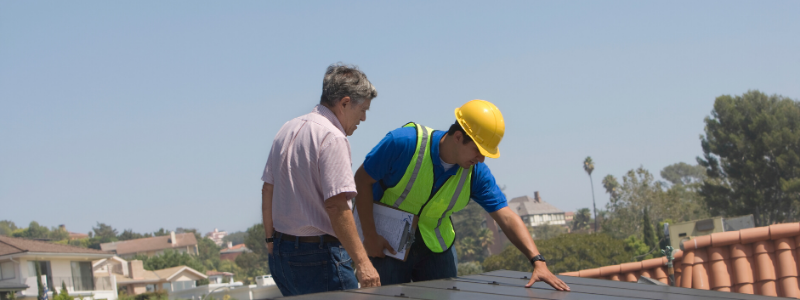
How Often Should I Have My Roof Inspected?
The National Roofing Contractors Association recommends that you have your roof inspected twice-per-year. By having your roof inspected twice-per-year, you can catch and prevent any significant problems before their true effects become apparent. But, if you have dealt with a significant weather event – such as a snowstorm – then it’s best to have your roof inspected sooner rather than later.
As a general rule, having your roof inspected twice-per-year is ideal. That way, you can catch, and prevent, any significant problems before they arise. But, if you experience a significant weather event or some very recognizable damage, then it’s important to have your roof inspected as soon as possible.
Right after roof damage is recognized, or a significant weather event takes place, a contractor can come out and inspect your roof. By doing this, you will learn all about the current state of the roof, the damage that took place, and what can be done to fix it. But, if you wait to do this, the damage may become worse, leading to bigger problems down the road.
At B&M Roofing, we offer a free estimate. By having us come over, you will be able to learn all about the current state of your roof, what kinds of repairs are needed, and how much all of that will cost.

